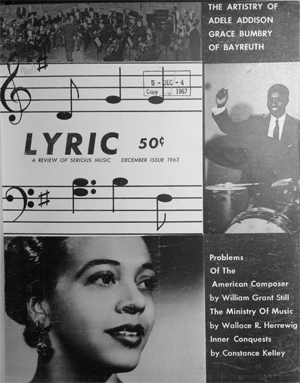The Lyric. A Review of Serious Music
Prepared by Richard Kitson
Online only (2021)

A periodical documenting aspects of African-American musical life during the time of the civil rights movement, Lyric. A Review of Serious Music [LYR] was printed and published irregularly by the Lyric Publishing Co. in Los Angeles, California, from September 1958 to February, 1967. Volume 1, Numbers 1 and 2 were published in September and November, 1958; Volume 1, Number 3 in December 1963. Volume 2, No. 1 appeared in January, 1964. Volume 3, Nos. 1 through 4, were published from September to December, 1966, and were followed by Volume 4, Nos 1 and 2 in January and February, 1967. The full extent of publication cannot be easily determined for few copies are extant; the editor confirmed the publication irregularity in later remarks.[1] Each issue comprises twenty-four pages printed in two-column or three-column format. Advertisements are found in the beginning and ending pages of the issues, including, of importance to Black readers, is the announcement of Opportunity Fellowships of the John Hay Harrison Foundation for those belonging to various ethnic groups in the United States.
The aims of the editor and publisher, Leroy E. Hurte, as expressed in the first issue, are “to raise musical, artistic and cultural standards, to serve as a voice for aspiring young artists, and to call attention to qualified Negro musical achievements that they may vie for recognition on a world cultural level.” Hurte also offers a pertinent editorial at the outset of the first issue, reiterating this message: “Raise musical, artistic and cultural standards . . . place Negro achievements on a world cultural level.” Hurte’s editorials in subsequent issues deal with choir members and their judgments of choir directors, the roles of choir directors and choir members as teachers of music appreciation to members of the congregation; and the basic objectives of a musical education.
Record reviews of compositions by Black composers feature William Grant Still’s Three Visions for piano, played by Gordon Manley, backed by the Afro-American Symphony Orchestra, and William Dawson’s Negro Folk Symphony played by the American Symphony Orchestra conducted by Leopold Stokowski. Biographical sketches are given for Black composers Ulysses Kay from Arizona (including remarks on his one-act opera The Juggler of Our Lady) and William Grant Still. In the realm of African-American folk music, the National Federation of Music Club’s annual award was won by Black folk music artist and entertainer Joel Hairston. Other review columns deal with local Los Angeles concerts and rehearsals.
The extensive concert and opera activities of Black instrumentalists and singers feature a great array of musicians with biographical notes and sketches and performance announcements and reviews, always enhanced with photographs: Toni LaVonne (harpist), Carlita Thomas and David Dudley (violinists), Henry Lewis (conductor), Simon Estes, Lawrence Winters, Robert McFerrin and Todd Duncan (baritones), Henry Boatwright (bass), Grace Bumbry, Shirley Carter, Shirley Verrett, and Betty Allen (mezzo-sopranos) Marian Anderson (contralto), Veronika Tyker, Phillipa Schuyler and Andre Watts (pianists), Leontyne Price, Mattiwilda Dobbs, Camilla Williams and Dorothy Maynor (sopranos), and Mahalia Jackson (gospel singer). The achievements of many other local Black singers and instrumentalists are also to be found in the pages of the journal.
An important aspect of the musical life of the Black communities concerns participation in church choirs of the Los Angeles region. Accompanied by copious photographs, the journal’s articles include discussion of the education and responsibilities of the church musician and the activities of various Los Angeles church choirs. Black instrumentalists found participation and employment in a number of symphonic ensembles in the area including the Angel City Symphony Orchestra, the Southeast Symphony Orchestra, the Los Angeles Community Symphony Orchestra, the Compton Symphony Orchestra and the Seventh Army Symphony Orchestra. Letters of support for the project of the International Symphony Orchestra, established for the purpose of promoting international amity through music and worldwide membership are reproduced in the journal.
The new cultural buildings at Lincoln Center, New York City, with particular emphasis on the new Metropolitan Opera House, opened with Leontyne Price in Samuel Barber’s opera Antony and Cleopatra, are important features. Photographic views of Lincoln Center Plaza, the entrance foyer and auditorium of the Metropolitan Opera House are included.
The section “Junior Lyric” offers musical crossword puzzles and other games with musical content and short biographical of the great musician for young readers. Poetry is to be found in most issues.
This RIPM Index was produced from a copy of the magazine held by the Library of Congress.
[1] See Leroy Hurte’s oral history at the Department of Special Collections at the University of California, Los Angeles: http://content.cdlib.org/view?docId=hb4m3nb6cj&brand=calisphere&doc.view=entire_text
